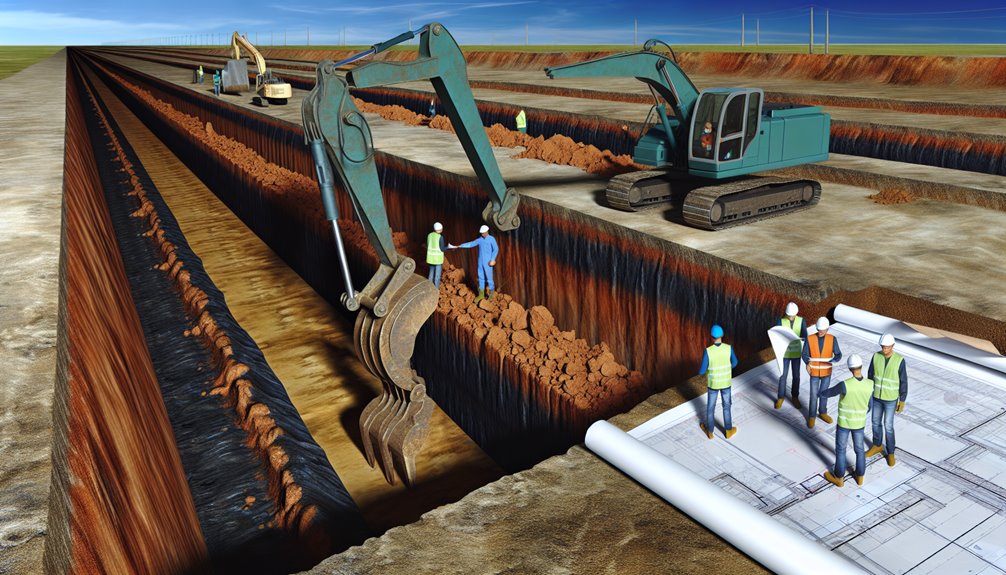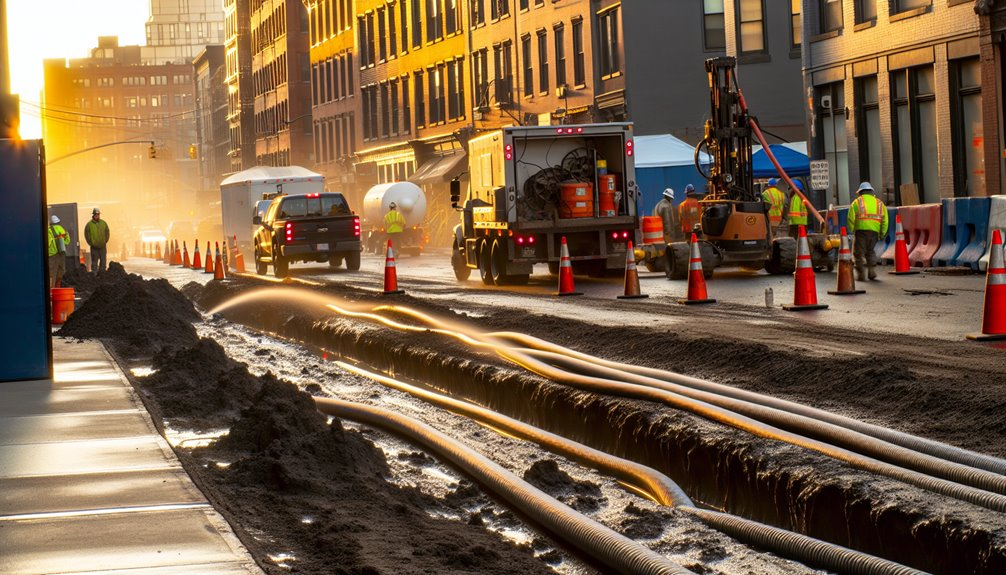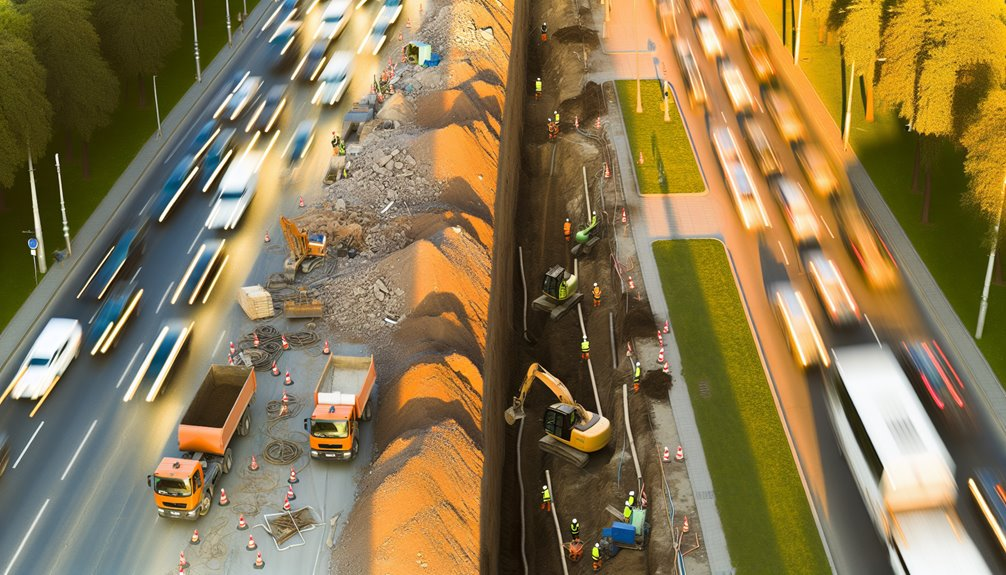When you're planning a trenching project, understanding the cost implications is vital. You'll find that expenses can vary greatly, primarily influenced by the site's soil type and the depth required for your utility installation. Opting for advanced trenching methods like microtrenching can minimize disruption and labor costs, yet the choice of technique must align with project specifics. As you navigate these decisions, it's important to reflect on how equipment rental and labor rates will impact your total budget, setting the stage for strategic financial planning in your upcoming ventures.
Understanding the Basics of Trenching Costs
When planning a trenching project, understanding the cost per linear foot is essential. Your trenching techniques and the specific utility installation directly impact these costs.
For a basic understanding, trenching ranges from $5 to $12 per linear foot. This variation stems from the type of utility—whether it's electrical, water, or gas.
A deeper exploration into cost analysis reveals that labor constitutes $3 to $9 of this cost, influenced by the complexity and duration of the job. Equipment rental sits at $2 to $3 per linear foot.
These figures don't just guide budgeting; they help you optimize resource allocation and strategy, ensuring your project remains innovative and economically feasible. Additionally, proper adherence to safety regulations throughout the trenching process can prevent costly penalties and project delays.
Factors Influencing Trenching Costs
As you plan your trenching project, it's vital to take into account various factors that can greatly influence overall costs.
Permit costs and local trenching regulations vary considerably by location, impacting your budget. Accessibility challenges may necessitate additional labor and specialized equipment, further elevating expenses.
Soil conditions play a key role; trenching through hard or rocky soil demands more robust techniques compared to softer terrains, thereby affecting the cost structure.
Additionally, the type of surface, whether dirt, asphalt, or concrete, dictates the required preparatory work, like saw cutting, which can drastically alter financial outlays.
Understanding these elements guarantees a more accurate estimation of your project's financial scope, aligning with innovative and efficient planning strategies.
Moreover, general contractor fees, which can add between 13% and 22% to the total cost, should also be considered in the financial planning of your trenching project, especially if overseeing large-scale or complex operations general contractor fees.
Choosing the Right Trenching Method and Equipment
Selecting the ideal trenching method and equipment is essential for the success of your project, as it directly impacts both cost and efficiency.
If you're tackling larger-scale projects requiring deep, wide trenches, conventional trenching with excavators or backhoes is advisable. However, if minimizing environmental disruption is paramount, consider trenchless techniques like HDD or microtrenching.
Your equipment selection should align with the project's specifics. Chain trenchers are perfect for swift, deep cuts in varied soil, excluding rock. For softer grounds, wheel trenchers offer rapid execution.
In confined spaces or detailed work, skid-steer loaders with trencher attachments provide unmatched versatility and precision, ensuring you meet both budgetary and environmental constraints efficiently.
Navigating Challenges and Obstacles in Trenching
After determining the appropriate trenching method and equipment for your project, you'll next need to address various challenges and obstacles that can arise during the trenching process.
A precise soil analysis is vital to anticipate and mitigate risks effectively. Here are key considerations:
- Soil Composition Analysis: Engage a professional to identify soil properties, essential for designing safety systems.
- Trench Stability Measures: Implement shoring, benching, and use trench boxes to prevent collapses.
- Hazard Management: Regularly inspect for hazardous atmospheres and guarantee proper ventilation.
- Environmental Awareness: Monitor weather impacts and nearby activities that could destabilize the trench.
- Safety Training: Provide ongoing training focused on recognizing and reacting to trenching hazards, in compliance with safety regulations.
Tips for Managing and Reducing Trenching Costs
To effectively manage and reduce costs in trenching projects, you must carefully assess both the site and the scope of the work involved.
Opt for microtrenching in urban settings to cut down on labor and disruption, or consider directional drilling in areas with complex landscapes to avoid costly excavations.
Implementing the unit cost method can lead to more transparent and predictable pricing.
When it comes to contractor selection, prioritize those with specialized equipment like Fiberblade technology, which enhances efficiency and trims labor expenses.
Additionally, evaluate the potential of compact rigs and directional drills that require fewer operators, further optimizing costs.
Each decision should align with the ultimate goal of cost optimization while maintaining project integrity.
Conclusion
To effectively manage your trenching costs, you'll need to carefully evaluate all influencing factors. Opt for advanced trenching methods like microtrenching or directional drilling to cut labor expenses and reduce environmental impact. Always select experienced contractors and guarantee detailed project planning to optimize resource use and maintain budget control. By thoroughly understanding these elements and applying strategic decision-making, you can achieve efficient and cost-effective trenching operations tailored to your specific needs.
If you're looking to dive deeper into trenching solutions, I invite you to visit Boring Bros at boringbro.com. You can also give us a call at (954) 639-6167. We're here to help and answer any questions you may have. Let's work together to make your trenching project a success!




